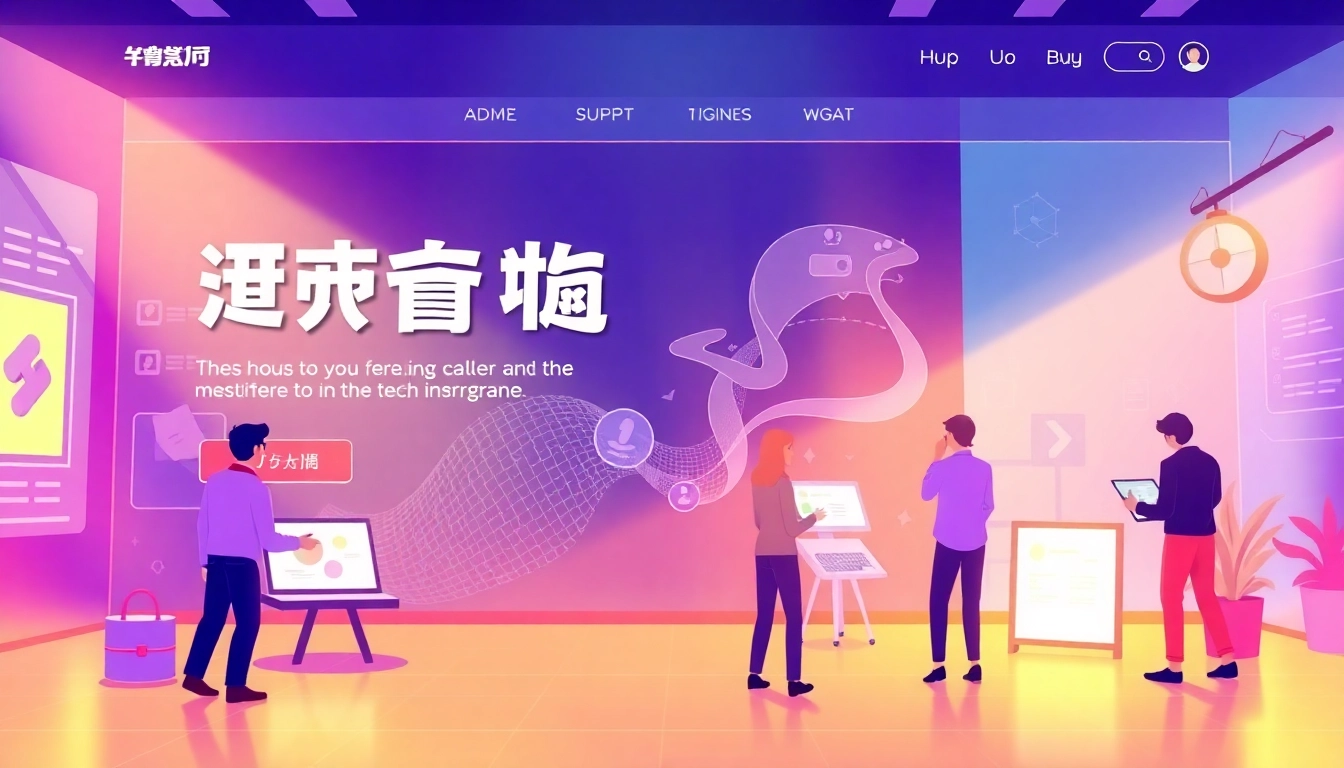Understanding AI Chat Bots
What is an AI Chat Bot?
AI chat bots are automated conversational agents powered by artificial intelligence, designed to engage with users in a conversational manner. Operating through textual or voice interactions, these chat bots leverage advanced algorithms to understand user queries, manage tasks, and provide responses that mimic human conversation. The capability of AI chat bots extends beyond simple pre-programmed responses; they harness natural language processing (NLP) and machine learning to adapt and improve their interactions over time.
Key Features and Benefits of AI Chat Bots
AI chat bots present an array of features and benefits that transform how businesses interact with customers. Firstly, they provide ai chat bot solutions that operate 24/7, ensuring that customers have access to support whenever they need it. Key features include:
- Natural Language Processing: This allows chat bots to comprehend and generate human-like text, making interactions smoother and more engaging.
- Multi-Channel Support: AI chat bots can function across various platforms, including websites, social media, and messaging apps, providing users with seamless communication experiences.
- Personalization: By analyzing user data, chat bots can tailor responses and suggestions based on individual preferences and past interactions.
- Scalability: AI chat bots can handle numerous queries simultaneously, making them ideal for businesses experiencing growth and high customer engagement levels.
- Cost Efficiency: Using chat bots reduces the need for extensive customer service teams, ultimately lowering operational costs while increasing productivity.
The combination of these features not only enhances customer satisfaction by providing instant support but also streamlines business operations, allowing human resources to focus on more complex tasks that require empathy and creativity.
Common Use Cases Across Industries
AI chat bots are versatile tools utilized across various industries, serving distinct purposes tailored to each sector’s unique demands. Here are some prominent use cases:
- Customer Service: Many organizations deploy chat bots to handle frequently asked questions, process returns, and assist users with product inquiries.
- E-commerce: In online retail, chat bots guide shoppers in selecting products, assist with checkout processes, and provide personalized recommendations based on shopping histories.
- Healthcare: AI chat bots are increasingly employed to book appointments, triage patient queries, and provide medication reminders, improving patient engagement and care.
- Finance: In the financial sector, chat bots assist clients in managing accounts, tracking expenses, and providing real-time updates on market trends.
- Travel: Travel companies use chat bots to facilitate flight bookings, provide itinerary updates, and address customer concerns promptly.
By adapting to the specific requirements of these sectors, AI chat bots have proven effective in enhancing efficiency and ensuring timely responses to customer needs.
Implementing an AI Chat Bot
Steps for Successful Deployment
The deployment of an AI chat bot necessitates a strategic approach to ensure it meets the needs of your business and customers effectively. Here are essential steps for successful implementation:
- Define Objectives: Clearly outline the goals you aim to achieve with the chat bot, be it improving customer service, enhancing user engagement, or driving sales.
- Identify Target Audience: Understand the needs, preferences, and behaviors of the users who will interact with the chat bot. This aids in designing effective responses and functionalities.
- Select Appropriate Technology: Invest in robust AI technology that supports NLP capabilities, machine learning, and analytics. This choice impacts the performance and adaptability of your chat bot.
- Design Conversational Flows: Create dialogue paths that facilitate smooth interactions. Anticipate user questions and map ideal responses to enhance user experience.
- Testing and Iteration: Conduct thorough testing to identify issues and areas for improvement. Gather feedback from trial users and iterate on the design based on their experiences.
Following these steps provides a strong foundation for a successful AI chat bot deployment that meets both business objectives and user expectations.
Choosing the Right AI Chat Bot for Your Business
When selecting an AI chat bot, several factors come into play to determine the most suitable option for your business:
- Functionality: Identify the features required by your organization, such as NLP, integration capabilities, and support for multiple languages.
- Customization: Choose a chat bot that allows easy customization to align with your brand’s voice and meet specific business needs.
- User Experience: Evaluate the interaction quality of the chat bot through demos or trial periods to ensure smooth and intuitive user experiences.
- Scalability: Prioritize chat bots that can scale easily to accommodate increased user traffic and expanding business operations.
- Support and Maintenance: Assess the vendor’s support system, as ongoing maintenance and updates are crucial for a chat bot’s long-term efficiency and effectiveness.
By carefully considering these factors, businesses can select chat bots that not only address current needs but also evolve with changing requirements in the future.
Integration with Existing Systems
Integrating an AI chat bot into your existing infrastructure is vital for maximizing its potential. Effective integration ensures seamless data flow and consistent customer experiences. Here are strategies for successful integration:
- API Utilization: Leverage application programming interfaces (APIs) to connect the chat bot with your Customer Relationship Management (CRM) system, e-commerce platform, or other internal software.
- Data Synchronization: Ensure that user data, preferences, and interactions are consistently synced across systems to provide accurate and personalized responses.
- Collaboration with IT Teams: Involve your IT department in planning integration, as their expertise will help avoid compatibility issues and streamline the installation process.
- Testing After Integration: Conduct thorough testing post-integration to check for any disruptions in service and ensure that the chat bot functions as intended in the live environment.
Successful integration sets the stage for a cohesive customer experience while maximizing the efficiencies that an AI chat bot can deliver.
Best Practices for Chat Bot Design
Create Engaging Conversation Flows
The design of conversational flows significantly impacts user engagement and satisfaction. Effective conversation design emphasizes clarity, brevity, and provides meaningful interactions:
- Use Simple Language: Ensure that the language used is simple and free of jargon to make communications accessible to all users.
- Be Direct: Avoid unnecessary steps in conversations. Be as straightforward as possible to guide users towards desired outcomes efficiently.
- Incorporate Visual Elements: Enhance conversations with buttons, quick replies, and rich media to improve interaction quality and make navigation easier.
- Utilize Context: The design should consider the context of users’ queries, creating pathways that anticipate user needs while maintaining relevance.
Adhering to these practices ensures that your chat bot provides seamless and engaging conversations that resonate with users, facilitating a positive experience.
Using Natural Language Processing Effectively
Natural Language Processing (NLP) is a cornerstone of advanced AI chat bots, allowing them to understand and interpret user inputs effectively. To leverage NLP effectively:
- Recognize User Intent: Employ advanced algorithms to identify what users intend through their queries, allowing for more accurate and relevant responses.
- Manage Variations: Train the chat bot to recognize different ways of asking the same question to ensure it provides consistent answers regardless of phrasing.
- Handle Ambiguity: Implement fallback strategies when faced with ambiguous queries, prompting users for clarification rather than providing incorrect answers.
- Continuous Learning: Utilize machine learning to refine NLP capabilities based on user interactions and feedback continuously, improving response accuracy over time.
Employing NLP effectively enhances the chat bot’s ability to interact naturally, contributing to an experience that feels personalized and accommodating.
Maintaining Brand Voice and Personality
Establishing a distinct brand voice through your AI chat bot turns routine interactions into memorable experiences. Consider these practices to maintain brand personality:
- Define Brand Attributes: Clearly outline the key attributes of your brand’s personality—are you friendly, professional, casual, or playful? Ensure the chat bot embodies these traits consistently.
- Craft Unique Responses: Avoid generic replies; instead, personalize responses that reflect the essence of your brand while addressing users’ specific needs.
- Utilize Humor Wisely: If applicable, appropriate humor can humanize your chat bot and make conversations more enjoyable. However, ensure it aligns with your audience and doesn’t detract from professionalism.
- Test Brand Tone: Regularly test interactions to see if users perceive the chat bot’s personality as intended and be open to adjustments based on feedback.
When successfully implemented, a strong brand voice not only enhances user experience but also fosters trust and loyalty among your audiences.
Measuring Success and Performance
Key Metrics for Tracking AI Chat Bot Effectiveness
To ascertain the effectiveness of your AI chat bot, it’s essential to measure and evaluate various performance metrics. Key metrics include:
- Engagement Rate: Analyze how frequently users interact with the chat bot and their level of engagement, measured through conversation length and interaction frequency.
- Resolution Rate: Track how many inquiries the chat bot resolves successfully versus those that require human intervention.
- Response Time: Measure the speed at which the chat bot responds to user queries, as quicker responses can enhance user satisfaction.
- Customer Satisfaction Score (CSAT): Gather feedback from users post-interaction to assess their levels of satisfaction with the chat bot’s responses.
- Retention Rate: Determine the percentage of users who return to interact with the chat bot, indicating its effectiveness and value to users.
Continuous monitoring of these metrics assists in refining the chat bot’s performance and ensuring it meets business and customer expectations.
Gathering User Feedback for Improvement
User feedback plays a critical role in enhancing the functionality and effectiveness of the AI chat bot. Strategies to effectively gather feedback include:
- Post-Interaction Surveys: Deploy short surveys immediately following interactions, asking users about their experience and satisfaction levels.
- Incorporating Churn Feedback: For users who cease interaction, solicit feedback on why they stopped using the chat bot, gaining insights to address potential issues.
- Monitoring Social Media Mentions: Keep an eye on social media platforms for user comments and discussions about the chat bot to gauge public perception and experiences.
- Utilizing Analytics Tools: Implement analytics tools that provide insights into user behaviors, identifying patterns that can inform adjustments to the chat bot.
By actively seeking and addressing user feedback, businesses can enhance their chat bot capabilities and user experience continually.
Adjusting Strategies Based on Data Insights
Data-informed decision-making is pivotal for optimizing AI chat bot performance. Key strategies for adjusting tactics based on insights include:
- Evaluating Performance Metrics: Regularly review performance data to identify trends, areas needing improvement, and the effectiveness of current strategies.
- Testing New Features: Use A/B testing to trial new functionalities or responses, measuring their impacts on user engagement and satisfaction.
- Identifying Knowledge Gaps: Analyze common user queries that the chat bot struggles to answer successfully, using this information to update its knowledge base accordingly.
- Setting Goals and Benchmarks: Establish clear targets for the chat bot’s performance based on insights and periodically assess progress against these benchmarks.
This continual cycle of assessing, adapting, and improving ensures that your AI chat bot remains relevant and effective in meeting user needs.
Future Trends in AI Chat Bots
Advancements in AI and Machine Learning
The landscape of AI and machine learning is continually evolving, presenting exciting advancements that enhance chat bot capabilities:
- Contextual Awareness: Future chat bots are likely to feature enhanced contextual awareness, understanding users’ needs based on prior interactions.
- Emotion Recognition: Progress in sentiment analysis may enable chat bots to detect user emotions, allowing them to respond appropriately and empathetically.
- Voice and Visual Interactions: As technology advances, expect chat bots to include advanced voice recognition and support for visual conversations, creating immersive user experiences.
- Integration with IoT: The integration of AI chat bots with Internet of Things (IoT) devices could lead to smart interactions where users control devices through conversational engagements.
Such advancements promise to enhance the functionality and impact of AI chat bots, elevating user experiences to unparalleled levels.
Emerging Applications in Business
As AI chat bots continue to evolve, their applications in business will grow, transcending traditional customer service roles:
- Internal Support Systems: Businesses may implement AI chat bots as internal resources, aiding staff with HR inquiries, IT support, and knowledge management.
- Sales and Lead Generation: AI chat bots are set to play larger roles in identifying potential leads, qualifying them, and even automating the sales follow-up process.
- Data Collection and Insights: They can gather and analyze user data more efficiently, allowing businesses to generate actionable insights without overwhelming teams.
- Training and Onboarding: AI chat bots could assist in training new employees, guiding them through onboarding processes and providing resources whenever needed.
The diversification of AI chat bot applications heralds a future where these tools play integral roles in business strategy and execution.
The Role of AI Chat Bots in Customer Experience
Ultimately, the role of AI chat bots in enhancing customer experience is paramount. As businesses continue to prioritize customer engagement, chat bots provide timely support and personalized interactions that meet expectations. Key roles include:
- Improving Response Times: AI chat bots drastically enhance responsiveness, offering immediate solutions that cater to users’ needs.
- Personalized Experiences: By analyzing user interactions and preferences, chat bots can deliver tailored suggestions, increasing relevancy in communications.
- Gathering Customer Insights: Chat bots can collect valuable data that informs product development and service improvement efforts, aligning offerings with customer expectations.
- Fostering Customer Loyalty: Enhanced experiences foster by AI chat bots help create lasting relationships between customers and brands, elevating brand loyalty.
The future of customer engagement hinges on the effective deployment of AI chat bots, making continuous improvement and adaptation crucial for sustained success.















Leave a Reply